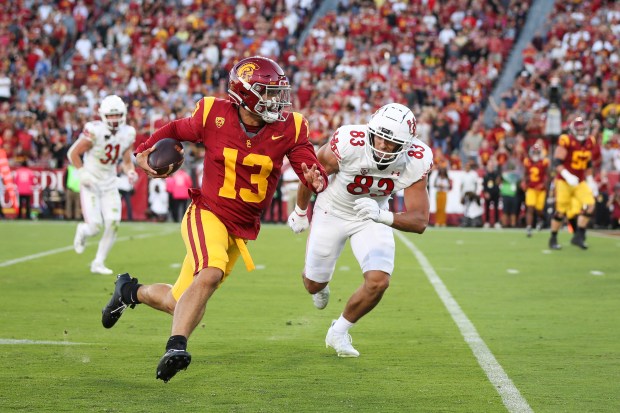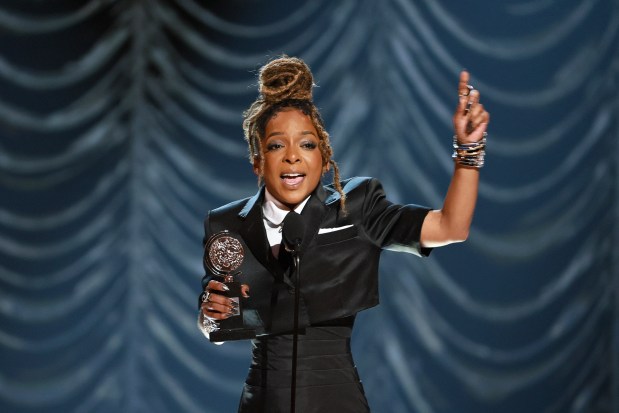MOBILE, Ala. — 10 thoughts after spending three days at the Senior Bowl, the event that really gets NFL draft season rolling. It’s a significant time for the Chicago Bears as they own the Nos. 1 and 9 selections.
1. At last year’s Senior Bowl, I asked a general manager for another team if he thought the Bears would consider trading the No. 1 pick.
“Oh, yeah,” he replied. “Why not?”
The question this week was similar when I crossed paths with GMs who are diving into draft preparation: What do you think the Bears will do at the top of the draft this time around?
The resounding answer from five GMs I spoke with was clear: Bears GM Ryan Poles will draft a quarterback with the top pick.
“They can say whatever they want,” one GM told me. “But, yes, they’ve got to take a quarterback.”
Another GM lightheartedly suggested the Bears could decide to use their draft capital to build around Justin Fields before admitting that was only wishful thinking on his part.
“They’re going to take a QB,” he said.
It was only a small cross-section of NFL decision makers, but those I spoke with had little doubt about the direction the Bears will choose. Poles’ decision is ultimately the only one that matters, but nothing I picked up in conversations with GMs, coaches, scouts and other front-office personnel led me to consider for a moment the Bears will opt to build a new offense around Fields.
It’s becoming a question of which quarterback the Bears choose — not if they will select a quarterback at No. 1 — and the only clarity at this point is that the evaluation process probably begins with USC’s Caleb Williams. Teams have three weeks to do homework on prospects before the next phase of the pre-draft process begins Feb. 26 at the scouting combine. The Bears will have their college scouts at Halas Hall for meetings before going to Indianapolis.
That preparation can include interviewing coaches and support staff who worked with prospects throughout their college and high school careers. Some of this work has been done. More is left to do. One would imagine the Bears got a pretty detailed view of Williams from Kliff Kingsbury, who was an analyst for USC last season, when they interviewed him for the offensive coordinator role that went to Shane Waldron.
The Bears surely will talk to teammates of Williams and other prospects to gather their insights, and this is where the narrative becomes a lot different than the noise generated on social media. I don’t get the sense there’s nearly as much baggage with Williams as you would imagine if you relied on social media for a snapshot of what he’d be like in the building or the locker room. Are there questions that need to be answered? Absolutely. There is plenty of time to work through all of that.
After the combine, the Bears will be busy hitting pro day workouts, scheduling top-30 visits (teams can bring in a maximum of 30 players for one day in the pre-draft process) and a handful of private workouts. Teams also can meet virtually with draft prospects, so there will be plenty of opportunities for the Bears to build a clear picture of Williams, North Carolina’s Drake Maye, LSU’s Jayden Daniels and every other imaginable prospect.
2. There would be great debate over what the Bears will do in the draft even if they didn’t own the No. 1 pick.
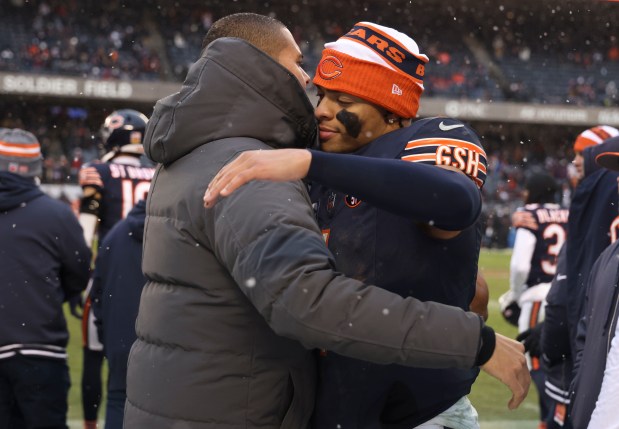
Bears quarterback Justin Fields hugs general manager Ryan Poles as they celebrate a win over the Falcons on Dec. 31, 2023, at Soldier Field.
They’re in position to get an impact player with the No. 9 selection, and Ryan Poles has an almost unlimited number of paths to choose.
The Bears’ needs are pretty defined after quarterback. They have to get a No. 2 receiver. They could consider an offensive tackle depending on how they evaluate Braxton Jones, their left tackle the last two seasons. They need a pass rusher opposite Montez Sweat.
Poles also could consider trading down to add more draft capital, but there’s a lot of unknown there — questions that might not be answered until the days leading up to the draft. Who are the possible trade partners? How far down would the Bears be comfortable moving? What would the compensation be?
In an ideal world, the Bears could recoup a second-round pick to make up for the one (No. 40) they shipped to the Washington Commanders in the Sweat trade. I’m not sure how realistic that is, though, unless they are comfortable trading way down in Round 1.
If you look at the Rich Hill draft trade value chart, the ninth pick is worth 387 points. The closest matches in Round 1 would be the Los Angeles Rams, who have the No. 19 (278 points) and No. 51 (112) picks. The Pittsburgh Steelers would also be a close match at No. 20 (269) and No. 52 (109).
Sure, the Bears could bundle more picks with No. 9 to get a higher pick in Round 1 and maybe a second-rounder back. The primary takeaway here is they would need a team that’s really motivated to get up to No. 9, and there’s a good chance the return package would not include a second-rounder.
All of that leads me to believe there’s a greater likelihood Poles is more inclined to stay where he is or consider only a small trade down. He needs his second Round 1 pick to be a hit, and moving down a good ways in Round 1 would turn that selection into more of a lottery ticket.
Back to the positions that could be in play here — wide receiver, offensive tackle and edge rusher — I think Poles will lean toward getting an offensive player to support the quarterback I expect the Bears to take at the top of the draft. The Bears invested heavily on defense last offseason in free agency and the draft, and this is an excellent draft for wide receivers and offensive tackles.
“Going to need to protect their quarterback,” a GM said when we chatted about possibilities at No. 9. “I’d look at linemen.”
If that’s the case, it’s worth wondering whether the Bears would experiment with Darnell Wright, the No. 10 pick last year, at left tackle. Maybe they can land a Day 1 starter at left tackle in the draft, but there are some intriguing prospects who need developmental time, and in that scenario, perhaps the Bears would want to see how Wright looks on the left side. Maybe they are pleased with Jones’ trajectory at left tackle. That remains to be seen.
If Poles is seeking an immediate impact player who can help a rookie quarterback right away, perhaps he goes the wide receiver route. There probably isn’t a wrong decision because there will be so many options.
3. There probably isn’t an offensive tackle candidate for the No. 9 pick playing in the Senior Bowl unless you fall in love with the projectability of Oklahoma’s Tyler Guyton, a massive 6-foot-7, 328-pounder who can really move.
Embed from Getty Imageswindow.gie=window.gie||function(c){(gie.q=gie.q||[]).push(c)};gie(function(){gie.widgets.load({id:’qpwKiu7ARgx2dpWy6bJNOg’,sig:’DQshpdfKqifbafGTor1UvkD8jWhyceWdoEz6m_JSrhI=’,w:’500px’,h:’333px’,items:’1968513803′,caption: false ,tld:’com’,is360: false })});
Darnell Wright played in the Senior Bowl last season, but the top tackle prospects in this year’s draft — Notre Dame’s Joe Alt, Penn State’s Ola Fashanu and Alabama’s J.C. Latham — are not in the game.
Guyton began his college career at TCU as a defensive lineman, switched to tight end and then became an offensive tackle, transferring to Oklahoma. He made only 14 starts the last two seasons for the Sooners but has all the tools you’d seek in a left tackle and probably could be developed to play that side — but it would take some time.
Oregon State’s Taliese Fuaga was impressive this week and probably had the most buzz coming to Mobile. Some wonder if he’ll ultimately become a guard in the NFL, but he could stick at right tackle. BYU’s Kingsley Suamataia is a physical right tackle who’s the cousin of Bears linebacker Noah Sewell. He’s another mountain of a man at 6-5, 330. Washington’s Roger Rosengarten showed off good feet in practice and probably projects as a right tackle as well.
A wide range of rounds is projected for these players, and all are worth keeping an eye on if you plan to watch Saturday’s game.
4. Miami’s Kamren Kinchens showed the kind of range in practice that will make him popular with teams seeking a free safety.
Miami’s Kamren Kinchens breaks up a pass intended for Clemson’s Brannon Spector on Nov. 19, 2022, in Clemson, S.C. (Eakin Howard/Getty Images)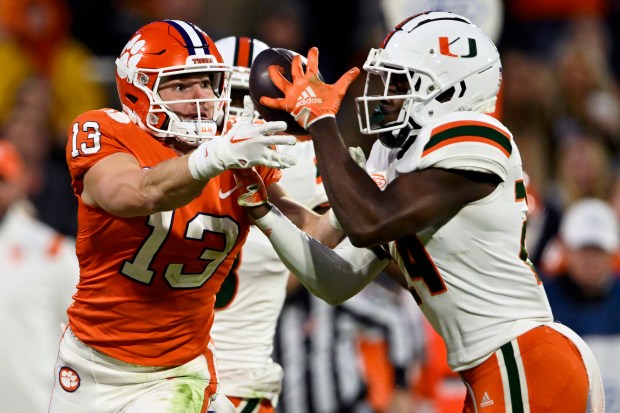
The thing that struck me when I chatted with Kinchens was his demeanor. I asked if he viewed himself as one of the best free safeties in the class, not just among the players at the Senior Bowl.
“I wouldn’t label myself as just a free safety,” he said. “I’m a safety. I can do it all. I can be closer to the box. I can cover. I can play in the post. I feel like I am one of the better safeties, and if you look at stats, I feel like I’m the best safety.”
Kinchens’ production for the Hurricanes was tremendous; he had 11 interceptions over the last two seasons. If the Bears decide to part with veteran Eddie Jackson — they can clear a little more than $12.5 million in salary-cap space if they release him — this will loom as a position of need.
Coaches I chatted with liked Kinchens’ size — he’s just over 5-11 and 206 pounds — and he was versatile at Miami when asked to play near the line of scrimmage and blitz. What will pop, though, are his skills on the back end, where he has proved to be a ballhawk.
“That’s what matters,” he said. “Get the ball in the offense’s hands. It’s being where the ball is at. It’s watching film. It’s knowing tendencies of what the quarterback likes to do.”
Kinchens said the most consistent question he got from teams during the week was about how he chooses to lead, and the Bears would be creating a major leadership void if they part with Jackson.
“I’m the kind of person that tries to lead by example and bring guys along,” Kinchens said. “And try to build the culture up.”
Kinchens projects as a late first-round pick or maybe more likely a second-rounder. He said his goal is to run a sub-4.5-second 40-yard dash at the combine.
5. Iowa’s Tory Taylor could be the highest-drafted punter in the NFL in more than a decade.
Embed from Getty Imageswindow.gie=window.gie||function(c){(gie.q=gie.q||[]).push(c)};gie(function(){gie.widgets.load({id:’fu3C-qwHSDFEEVtof7tkZg’,sig:’HwzY3QMZl5O0sqy7li98CI_xCJQJO-uiZkIYVP7gTik=’,w:’500px’,h:’333px’,items:’1815548462′,caption: false ,tld:’com’,is360: false })});
He’s someone to keep an eye on for the Bears, who at minimum will want to provide serious competition for Trenton Gill.
The last punter chosen in the second round was Todd Sauerbrun, whom the Bears drafted out of West Virginia in 1995. Only four punters have been selected in the third round since then: Bryan Anger (Jaguars, 2012), Dustin Colquitt (Chiefs, 2005), B.J. Sander (Packers, 2004) and Brad Maynard (Giants, 1997). Eight punters were drafted in the fourth round from 1995 through 2023.
I’m not saying Taylor will go in Round 2, but I’d be stunned if he makes it out of the fourth round and he could have his name called earlier. Taylor dazzled in practice this week with his ability to land punts inside the 10- and 5-yard lines with bounce and spin that made them easier to cover. His kicks can be difficult to catch and he has excellent accuracy.
“His best ball, when he is really relaxed and you just let him be an athlete, is around the 50-yard line,” said Hawkeyes special teams coordinator LeVar Woods, who was a linebacker on the Bears offseason roster in 2005. “There is no one like him. His drop punts that he’s putting inside the 10, inside the 5 — unreal. When he just cuts loose and lets it go, he can place it wherever he wants to put it.
“I know this: Tory Taylor could roll out of bed on two hours’ sleep and hit a drop punt 45 yards fair caught every day if he wanted to.”
Taylor, 26, came from Australia to enroll at Iowa straight out of COVID-19. He was a complete unknown in the football world, and the first game he saw in person was the first game he played for the Hawkeyes.
Taylor was working at a golf club and had a construction job out of high school in Australia. He was considering going to school for a degree in construction management when he instead decided to try ProKick, a kicking camp in Australia.
“There are a lot of good Aussie guys over there, and you never really know until you start trying,” Taylor said. “When I first walked out to practice I was like, ‘Oh, is this for me?’ There were guys smoking balls.
“At the end of the day, I really enjoyed it. I joined ProKick and it took me in a completely different direction. It’s certainly a lot more enjoyable than working.”
A national scout joked that Taylor was the Hawkeyes’ best player last season. Defensive back Cooper DeJean might lay claim to that designation, but the point was Iowa didn’t have many better players than their punter.
“Tory knew nothing when he got here,” Woods said. “Every day. Every practice. Every rep. Just seeing how much he improved was amazing. If you think about it, you’re asking a guy — he was a little bit older, he was 22 — but you’re asking a guy to come over who knows nothing about a sport and you just insert him and expect him to do well.
“As he got going, it became pretty obvious, ‘Hey, the kid is pretty good.’ And then our team started to rely on him to get us out of bad situations with field position. Or once he started pinning people on the 1- and 2-yard line, it became, ‘(Shoot), this is like a weapon.’ Then it became a little bit more fun. What can you do? What’s your best ball? Where can you place this thing?
“If you are talking about impact in a game and relying on him whenever called upon, I would say that’s accurate” that he was among Iowa’s best players.
Taylor isn’t caught up in where he will go in the draft. He said he’s focused on consistently hitting a spiral punt and being effective with other clubs in his bag.
“That’s out of my control,” he said. “Just trying to get better.”
6. Center also looms as a position of need for the Bears, and it’s going to be interesting to see how they attack it.
Embed from Getty Imageswindow.gie=window.gie||function(c){(gie.q=gie.q||[]).push(c)};gie(function(){gie.widgets.load({id:’cMNvCsYqQPxO6YCA1UN3Fw’,sig:’FSH4Rb7kH5kEi2KYfzZ38HwWtIukNFjboSWVW7ypVAM=’,w:’500px’,h:’333px’,items:’1829295926′,caption: false ,tld:’com’,is360: false })});
They could go the free-agent route, but I am expecting them to be less active than they were a year ago on the open market. It would be a bit of an upset if there were a bigger deal to be done than the one the Bears try to hammer out with cornerback Jaylon Johnson.
It wouldn’t be surprising if the team considered some veterans in free agency to anchor the line, but you can’t rule out the draft. There are a pair of good ones at the Senior Bowl in Oregon’s Jackson Powers-Johnson and West Virginia’s Zach Frazier.
Powers-Johnson measured a shade over 6-foot-3 and 334 pounds, and my guess is NFL teams would want him to drop a little weight. It’s not that he doesn’t carry it well, but if he’s playing center — or guard (he got reps at both positions this week) — they want him to be able to move well.
“I like inside zone more,” Powers-Johnson said when asked about his preferences, perhaps shining a light on his personality. “It’s more of an identity play. It’s the OG run play. Doing that against the defense is demoralizing.
“We ran a lot of outside zone at Oregon all three years I was there. It would be seamless (transition to that). I love pulling. I love running in space. I love the ferocity of outside zone and if a team needs me to do that, I am going to do that.”
Frazier suffered a broken fibula in the final minute of the Mountaineers’ win against Baylor on Nov. 25. He hasn’t been cleared to return to action but was in Mobile participating in some drills and going through the process. A four-time state wrestling champion in high school, he’s an appealing option for teams in the market for a center.
“Incredibly good with his upper body,” a scouting director said about Frazier. “He’s got very, very good strength. He can torque and twist and control people with his hands. He can drive block, displace defenders, he can sit down on zero techniques trying to run power through him. He does struggle a little bit with some edge speed and a little bit of counter in the rush. He’s good at getting to the second level and he’s gotten better, but being able to sustain (at the second level) wasn’t there early. He wasn’t finishing with his feet. Somebody will take him in the top half of the second round.
“The kid from Cincinnati (Dontay Corleone) that will be a first-round pick next year, defensive tackle, he kicked his ass. Throw on the tape of that game. He got better this past year.”
Some are of the mindset that it would be tough for a team to pair a rookie quarterback with a rookie center. But in talking to a few folks, it would depend on the center.
“If the center is competent enough about changing protections and making line calls and everything else, I don’t think that is a big deal,” an offensive coordinator said. “It takes some off the quarterback to help him out a little bit. It depends on what the quarterback has to learn too. Not a lot of quarterbacks in college football have to ID the mike (linebacker), change the protection after a mouthful of calls. It depends on that. I’d say no, it’s not a problem, unless you were not comfortable with the way the center could set the front, change the protection and all of that if you’re going to put that on him.”
7. Ron Rivera first crossed paths with new Bears defensive coordinator Eric Washington in 2005, when Washington joined the Bears in training camp as part of the Bill Walsh minority coaching fellowship program.
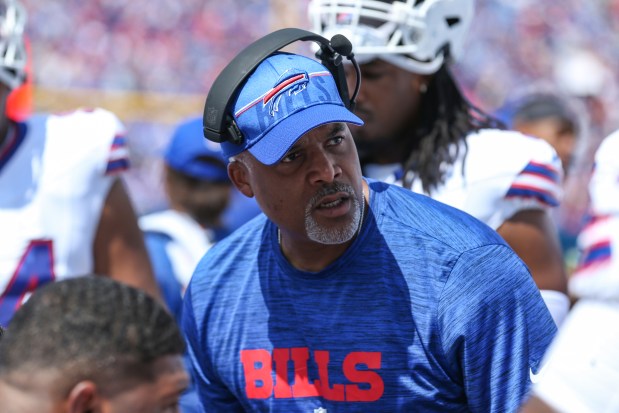
Washington was the defensive line coach at Northwestern at the time. He made a positive impression on the staff, and Lovie Smith hired Washington as a defensive assistant in 2008. Two years later, after Rod Marinelli was promoted to defensive coordinator, Smith elevated Washington to defensive line coach. That made it a no-brainer for Rivera to hire Washington in 2011 when he was seeking a D-line coach in Carolina.
The connection — Rod Marinelli was an assistant at Cal when Rivera played there — is the same one Bears coach Matt Eberflus likely was leaning on. Eberflus considers Marinelli one of his greatest mentors.
“I knew Eric was trained by Rod and that is what appealed to me more than anything else,” Rivera said this week. “He probably is one of the best defensive line coaches around. He’s an outstanding pass-rush coordinator, in terms of setting it up and knowing how to use it. He’s very, very good at that.
“You can see his influence on the way they rush for Buffalo.”
Washington worked under Rivera for nine seasons in Carolina, serving as the defensive line coach for the first seven and then as defensive coordinator. Washington went from there to Buffalo with Sean McDermott and directed the defensive line for the Bills and also earned the title of assistant head coach.
“Eric will do a great job explaining it,” Rivera said. “It will be very detailed. Very well put together. He knows how to fit the run. He knows how to stop the run. His pass rush game is phenomenal. He’s going to be very good with that. Guys like (Montez) Sweat, they’ll get better.”
Washington, who played tight end at Grambling for legendary coach Eddie Robinson, is pretty reserved and can be quiet. But Kawann Short, a two-time Pro Bowl defensive tackle for the Panthers who went to Central High School in East Chicago, Ind., said he has no problem envisioning Washington addressing the entire defense.
Embed from Getty Imageswindow.gie=window.gie||function(c){(gie.q=gie.q||[]).push(c)};gie(function(){gie.widgets.load({id:’NNS0NY9tSCFmwI8VaNhRDg’,sig:’wVwGyuwlTW7at3p4Gz9murgjtS2azygA13k7natAvh0=’,w:’500px’,h:’333px’,items:’1173181670′,caption: false ,tld:’com’,is360: false })});
“Man, honestly, Coach Washington was the driver of the car,” Short said. “Just him being the behind-the-scenes type of guy, very quiet, but Coach Wash, we’ve grown to build a relationship damn near like a father-son. Going in that room early, meeting before the day got started, one-on-ones, he motivated me to be the best player I could be in Carolina. To this day, I appreciate him dearly.
“He means business. In between work and practice and all that stuff, he’s a focused and success-driven guy. He’s trying to get the best out of his players. He’s going to do whatever it takes. He puts in the work to make sure you take the extra step as a player. Being with him elevated my game 10 times as much. I had the athleticism and the ability to play. He made me look at the game a lot differently. He showed me what to look for and he simplified the game for me and made me that much better.”
Short said that Washington was a primary reason he and Star Lotulelei, defensive tackles the Panthers selected in the first two rounds in 2013, had an immediate impact in the NFL.
“I could sit here and tell you about every meeting we had,” Short said. “From day one, the most important thing he told me once I got to Carolina was, ‘There’s no redshirt year.’ You know what that means — practicing and not playing. That was his mentality. I don’t care if you’re Year 1, a free-agent pickup or a practice-squad player, he’s going to teach every guy in that room and if we were to play tomorrow, we’d be ready.
“I was second round and Star Lotulelei was (first round). He sat us down and said, ‘Look, we drafted you guys because we know you can do it. We know you are the right personnel for this defense. I vouched for you guys and one thing I want is don’t let yourselves down. Not me. Don’t let yourselves down. I know you can do it. We’ve just got to figure it out and pull it up out of you.’ ”
With second-year defensive tackles in Gervon Dexter and Zacch Pickens, the Bears surelyare hoping Washington can help make an immediate impact.
Washington isn’t the only Bears staffer from the latter years of the Smith era at Halas Hall to be named a defensive coordinator recently. The Tennessee Titans are hiring Baltimore Ravens secondary coach Dennard Wilson as DC. Wilson was a pro scout for the Bears from 2008-11.
8. Talent in this draft is expected to drop off on Day 3 (Rounds 4-7).
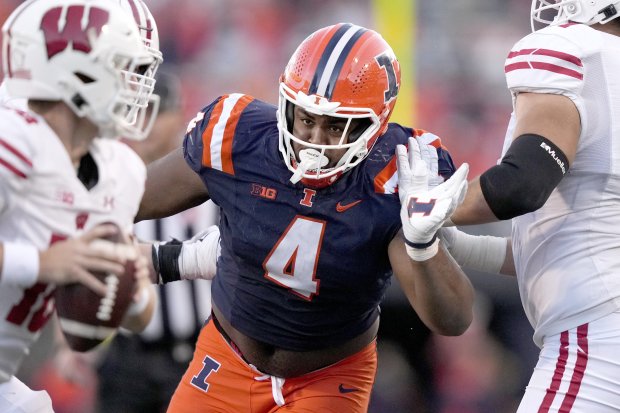
It’s not that this is considered a weak class necessarily, but only 54 players were granted early entry to the draft. The number was 63 a year ago, 73 in 2022 and routinely reached triple digits in previous years.
Ohio State offers a prime example of talented players deciding to return to school. Buckeyes wide receiver Marvin Harrison Jr. opted to head to the NFL, but wide receiver Emeka Egbuka, cornerback Denzel Burke, edge rushers J.T. Tuimoloau and Jack Sawyer and offensive lineman Donovan Jackson all decided to stay in school.
“It’s going to fall off in a hurry starting in Round 5,” said one GM said, adding there was almost an entire round of solid players that chose to wait at least a year to turn professional.
Said one national scout: “NIL has a lot to do with it, if not all to do with it. I think it’s going to continue that way too.”
I asked how he grouped players who were leaving school early in the past when the number was around 100 or even higher.
“You can understand why a lot of them were or are coming out,” the scout said. “Probably 15% to 25% are just making poor decisions. Then there’s probably 50% that are worthy of coming out early, players that have that type of value. I’m just pulling these numbers off the top. There’s probably 25% that are good enough and they’re not getting any better, so why not enter the draft? Then, like I said, there were as much as about 25% that were just making a bad decision.
“There are a lot of good players going back to Columbus — Day 1, Day 2 picks. Are they going to get significantly better? Probably not. It’s interesting.”
Illinois defensive tackle Johnny Newton stayed in school when he could have gone into the draft last year, and he stands as an example of a player who probably enhanced his stock.
“Johnny was probably an early Day 3 pick last year, a fourth-rounder maybe,” the scout said. “If you look at all the mock drafts, he’s a first-round pick unanimously. I think that’s rich for him. I could be wrong. But he’s in a better spot for sure.”
The scout said that the number of players who returned to school this year will enhance the 2025 draft.
“Next year is going to be a crazy draft class because you’re going to have all of those players that could be early entrants that are going back to school,” he said. “So, they’re going to be in the draft next year. Then you have all of the COVID guys, dudes that got an extra year of eligibility because of COVID, that are going to be in the draft next year and then you’ll have the normal amount of players that will be in the draft next year. It’s going to be just a lot of names. Rounds 5 through 7, there will be a lot of players. A lot more than there are this year.”
9. Illinois right tackle Isaiah Adams put together a solid week of practice.
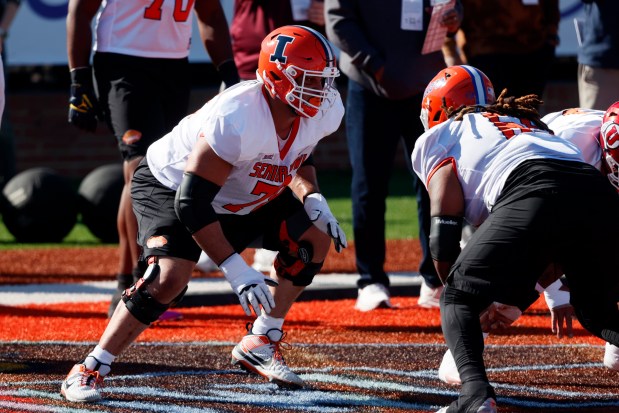
He has been working inside at guard, which is where he played in 2022 for the Illini. Coach Bret Bielema told me during the season it was a move based on necessity — what was best for the team — that kicked Adams out to right tackle.
It’s probably something that ultimately helped Adams, too, as it diversified his resume a little.
“It definitely was not a bad thing,” Adams said. “I kind of got comfortable on the right side. If I need to play right guard, it’s only going to help me.”
Adams, who is training with Duke Manyweather in Frisco, Texas, could wind up being a midround pick.
“This week teams have been wanting to see what my football IQ is and what this game means to me,” he said. “That’s sort of the common theme right now. Some of them brought up plays from last year and what our calls were, why I set a certain way. Lot of white board and a lot of video. It’s been a good experience.”
10. Eight teams — one-fourth of the league — have changed head coaches with the last openings filled this week.
The Bears are scheduled to play five of those clubs in 2024: the Seattle Seahawks (Mike Macdonald), Tennessee Titans (Brian Callahan), Carolina Panthers (Dave Canales), New England Patriots (Jerod Mayo) and Washington Commanders (Dan Quinn).


